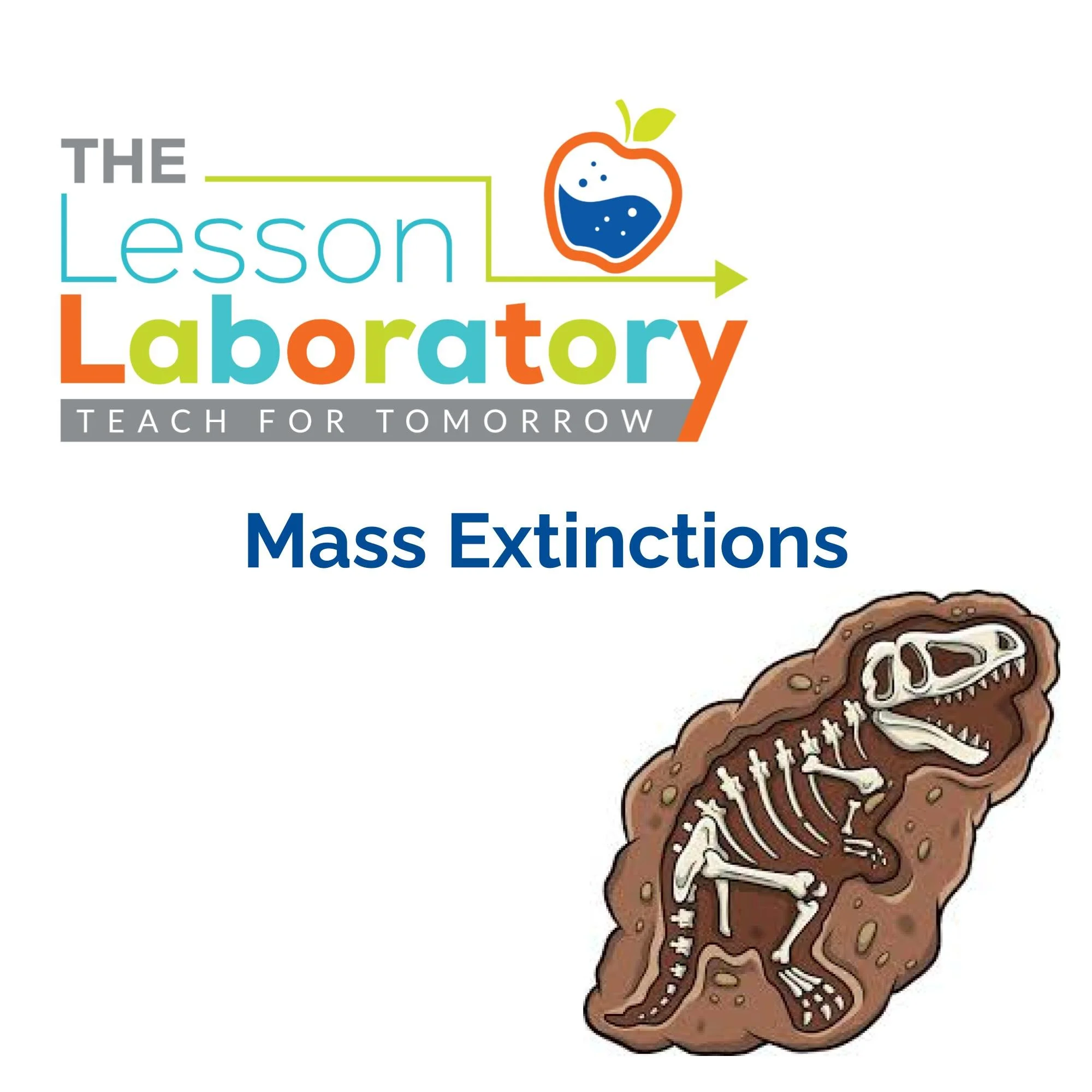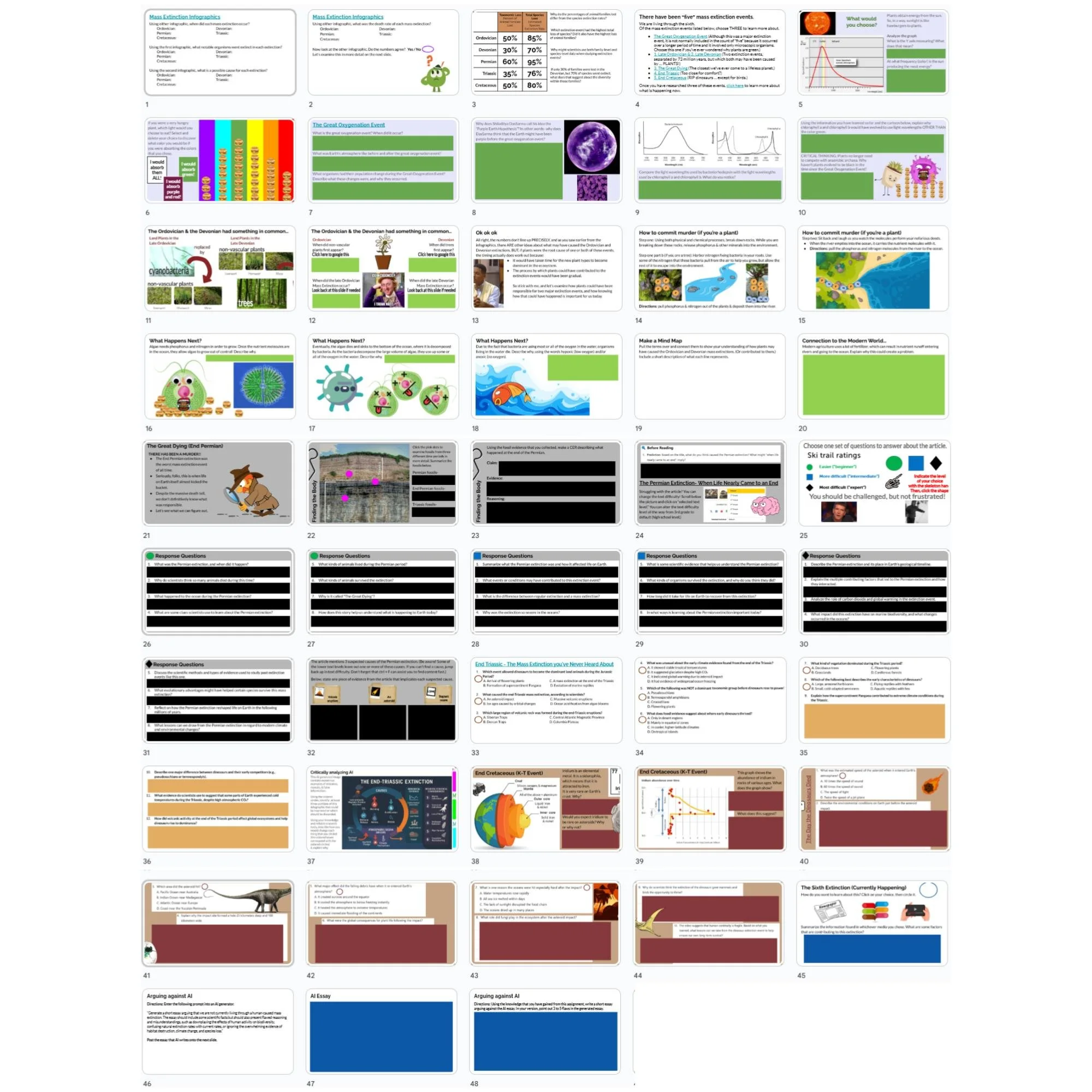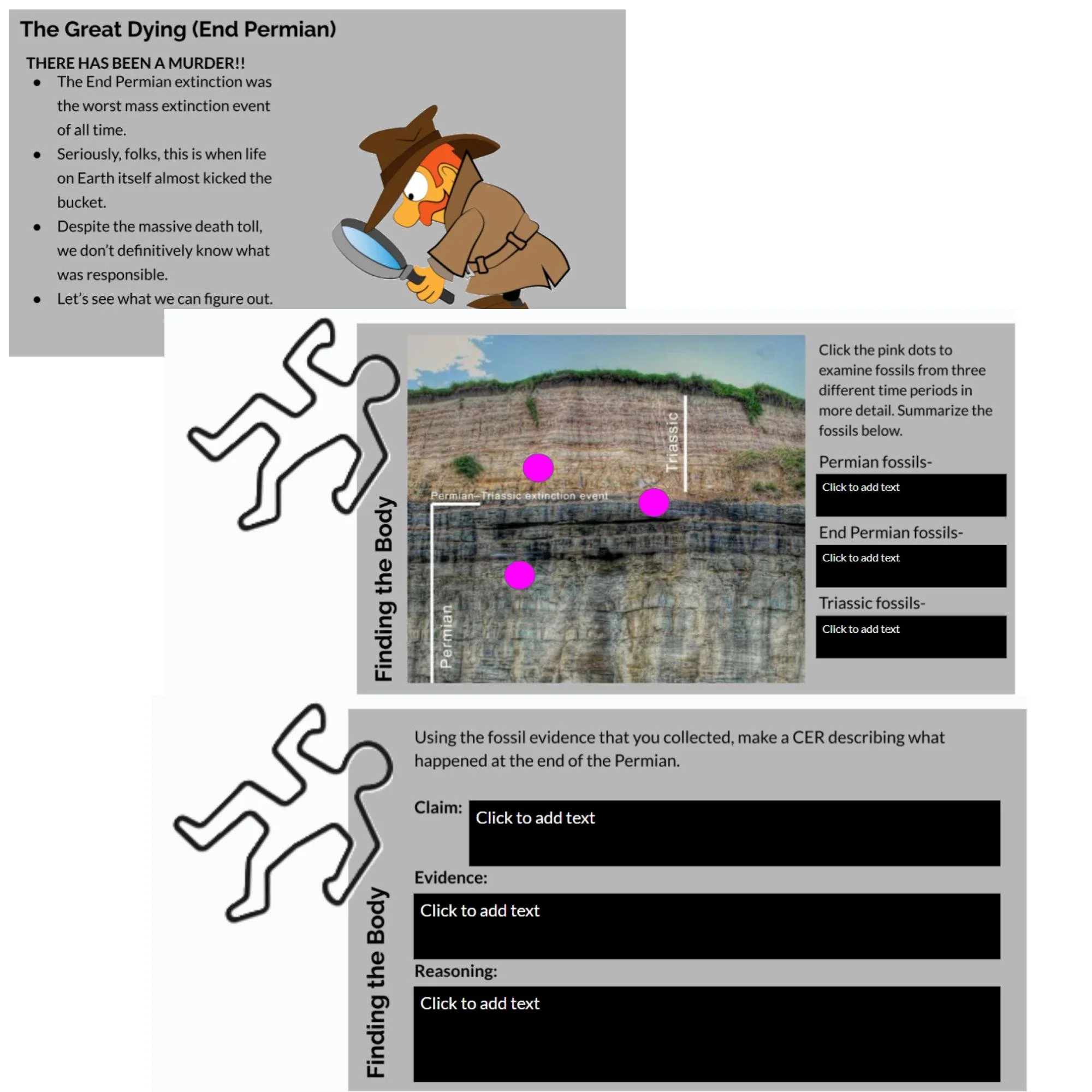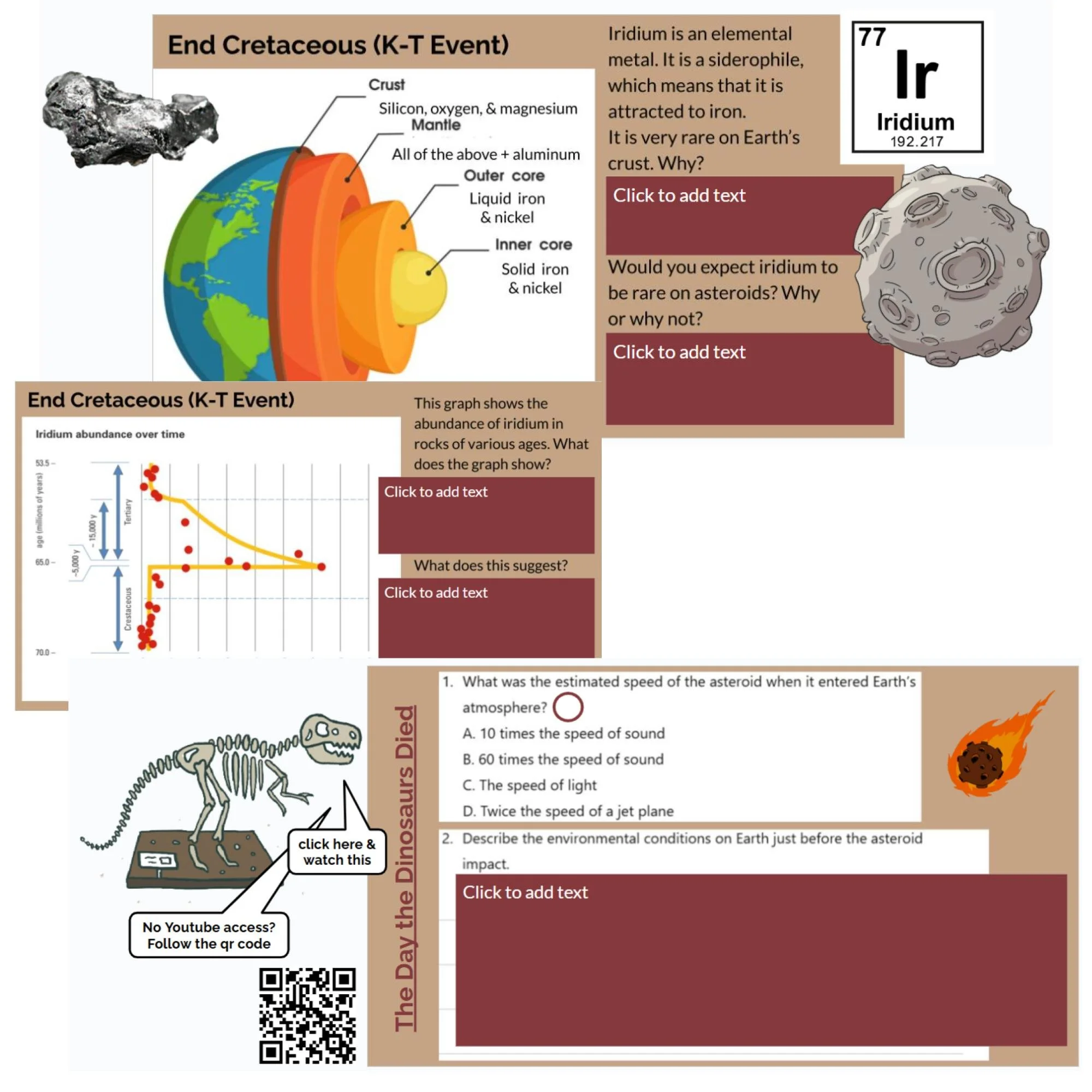



Mass Extinctions
Mass Extinctions: A Lesson in Earth’s Greatest Turning Points
Take your students on a journey through the most dramatic events in Earth’s history—the mass extinctions that reshaped life on our planet. This interactive lesson blends inquiry, choice, and critical thinking, giving students the tools to explore extinction events in depth while drawing meaningful connections to modern issues.
🌍 What’s Inside:
Start Big: Students begin by analyzing infographics comparing the timing, causes, and scope of the five major mass extinction events.
Student Choice: Each learner then dives deeper into three out of five additional extinction events, choosing from the following engaging options:
The Great Oxygenation Event: Why are plants green? Students explore energy use, the “purple world hypothesis,” and how early life may have shaped Earth’s biosphere.
The Plant Revolution: Did plants trigger the Ordovician and Devonian extinctions? Students map out how new plant life may have caused nutrient overload, algal blooms, and anoxic oceans—then compare it to today’s human-driven dead zones.
The Great Dying (Permian Extinction): Students evaluate fossil evidence with a CER activity, read differentiated articles (available from elementary to advanced levels), and explore multiple possible causes.
The End Triassic Extinction: Students watch a video and then fact-check an AI-generated infographic, sharpening their science literacy by spotting misinformation.
The KT Event (End Cretaceous): From iridium layers to asteroid impacts, students analyze evidence, then watch an engaging video that vividly explains the catastrophic aftermath of the strike that wiped out the dinosaurs.
3. The Sixth Extinction: Students end by examining today’s biodiversity crisis. They choose their medium (article, infographic, or video), then challenge AI by critiquing a flawed essay arguing against the current extinction.
✨ Why Teachers Love It:
Differentiated by design: Choices in reading levels, question sets, and activity formats give every student access to the material.
Built-in choice keeps students engaged and invested.
Inquiry-based structure helps students practice analysis, evidence-based reasoning, and critical evaluation of scientific claims.
Perfect balance of content mastery and higher-order thinking skills.
Your students won’t just memorize the “big five” extinctions—they’ll analyze evidence, weigh hypotheses, and connect past events to today’s challenges. By the end, they’ll see extinction not just as history, but as a window into the resilience (and fragility) of life on Earth.
Grade & Course Recommendation:
Middle School: Grades 7–8 Earth & Life Science, biodiversity and change over time unit.
High School: Grades 9–10 Biology or Earth Science, macroevolution and geologic time unit.
Cross-Curricular Connections:
History of Science Integration: Connection to fossil record discoveries and scientific revolutions.
ELA Integration: Summarizing informational text and writing hypotheses.
Geology Integration: Understanding strata and fossil dating methods.
Daily slide + literacy - based exit ticket included with purchase
Join the Lesson Laboratory and Teach for Tomorrow!
Mass Extinctions Lesson → NGSS Alignment
Disciplinary Core Ideas (DCIs):
HS-LS2-7: Design, evaluate, and refine a solution for reducing the impacts of human activities on the environment and biodiversity.
→ Students compare past extinctions to the present “sixth extinction” and critique flawed arguments about whether it’s happening.HS-LS4-1: Communicate scientific information that common ancestry and biological evolution are supported by multiple lines of empirical evidence.
Connection: Students use fossil and chemical evidence to analyze past extinction events and evolutionary recovery patterns.HS-LS4-5: Evaluate evidence that the change in environmental conditions may result in an increase in some species, the emergence of new species, and the extinction of others.
→ Students analyze infographics, fossil evidence, and scientific articles about mass extinctions and their causes.HS-ESS2-7: Construct an argument based on evidence about the simultaneous coevolution of Earth’s systems and life on Earth.
→ Students explore how events like the Great Oxygenation Event and plant evolution reshaped Earth’s systems.HS-ESS3-1: Construct an explanation based on evidence for how natural resource availability, natural hazards, and climate have influenced human activity.
→ Modern eutrophication and dead zones link past mass extinctions to current human-driven ecological change.
Science & Engineering Practices (SEPs):
Analyzing and Interpreting Data: Infographics, graphs (iridium spike, oxygenation, eutrophication), fossil evidence
Engaging in Argument from Evidence: CER on Permian extinction, AI essay critique
Constructing Explanations: Why plants are green, causes of extinctions, asteroid impact evidence
Obtaining, Evaluating, and Communicating Information: Comparing reliable scientific sources with flawed/AI-generated ones
Crosscutting Concepts (CCCs):
Cause and Effect: Linking extinction drivers to outcomes
Stability and Change: Ecosystem collapse and recovery
Systems and System Models: How Earth’s systems (atmosphere, hydrosphere, biosphere) interact with life
Common Core Standards
Grades 9–12:
CCSS.ELA-LITERACY.RST.9-10.1 / RST.11-12.1: Cite specific textual evidence to support analysis of science and technical texts. (Students use evidence from infographics, videos, and articles to support claims.)
CCSS.ELA-LITERACY.RST.9-10.7 / RST.11-12.7: Integrate quantitative or technical information expressed in words with visual information (infographics, timelines, fossil data).
CCSS.ELA-LITERACY.RST.9-10.8 / RST.11-12.8: Assess the validity of reasoning and the relevance of evidence in scientific arguments. (Students critique flawed reasoning in the AI-generated essay.)
CCSS.ELA-LITERACY.WHST.9-10.1 / WHST.11-12.1: Write arguments focused on discipline-specific content. (Students compose evidence-based rebuttals explaining flaws in the “not a mass extinction” argument.)
Mass Extinctions: A Lesson in Earth’s Greatest Turning Points
Take your students on a journey through the most dramatic events in Earth’s history—the mass extinctions that reshaped life on our planet. This interactive lesson blends inquiry, choice, and critical thinking, giving students the tools to explore extinction events in depth while drawing meaningful connections to modern issues.
🌍 What’s Inside:
Start Big: Students begin by analyzing infographics comparing the timing, causes, and scope of the five major mass extinction events.
Student Choice: Each learner then dives deeper into three out of five additional extinction events, choosing from the following engaging options:
The Great Oxygenation Event: Why are plants green? Students explore energy use, the “purple world hypothesis,” and how early life may have shaped Earth’s biosphere.
The Plant Revolution: Did plants trigger the Ordovician and Devonian extinctions? Students map out how new plant life may have caused nutrient overload, algal blooms, and anoxic oceans—then compare it to today’s human-driven dead zones.
The Great Dying (Permian Extinction): Students evaluate fossil evidence with a CER activity, read differentiated articles (available from elementary to advanced levels), and explore multiple possible causes.
The End Triassic Extinction: Students watch a video and then fact-check an AI-generated infographic, sharpening their science literacy by spotting misinformation.
The KT Event (End Cretaceous): From iridium layers to asteroid impacts, students analyze evidence, then watch an engaging video that vividly explains the catastrophic aftermath of the strike that wiped out the dinosaurs.
3. The Sixth Extinction: Students end by examining today’s biodiversity crisis. They choose their medium (article, infographic, or video), then challenge AI by critiquing a flawed essay arguing against the current extinction.
✨ Why Teachers Love It:
Differentiated by design: Choices in reading levels, question sets, and activity formats give every student access to the material.
Built-in choice keeps students engaged and invested.
Inquiry-based structure helps students practice analysis, evidence-based reasoning, and critical evaluation of scientific claims.
Perfect balance of content mastery and higher-order thinking skills.
Your students won’t just memorize the “big five” extinctions—they’ll analyze evidence, weigh hypotheses, and connect past events to today’s challenges. By the end, they’ll see extinction not just as history, but as a window into the resilience (and fragility) of life on Earth.
Grade & Course Recommendation:
Middle School: Grades 7–8 Earth & Life Science, biodiversity and change over time unit.
High School: Grades 9–10 Biology or Earth Science, macroevolution and geologic time unit.
Cross-Curricular Connections:
History of Science Integration: Connection to fossil record discoveries and scientific revolutions.
ELA Integration: Summarizing informational text and writing hypotheses.
Geology Integration: Understanding strata and fossil dating methods.
Daily slide + literacy - based exit ticket included with purchase
Join the Lesson Laboratory and Teach for Tomorrow!
Mass Extinctions Lesson → NGSS Alignment
Disciplinary Core Ideas (DCIs):
HS-LS2-7: Design, evaluate, and refine a solution for reducing the impacts of human activities on the environment and biodiversity.
→ Students compare past extinctions to the present “sixth extinction” and critique flawed arguments about whether it’s happening.HS-LS4-1: Communicate scientific information that common ancestry and biological evolution are supported by multiple lines of empirical evidence.
Connection: Students use fossil and chemical evidence to analyze past extinction events and evolutionary recovery patterns.HS-LS4-5: Evaluate evidence that the change in environmental conditions may result in an increase in some species, the emergence of new species, and the extinction of others.
→ Students analyze infographics, fossil evidence, and scientific articles about mass extinctions and their causes.HS-ESS2-7: Construct an argument based on evidence about the simultaneous coevolution of Earth’s systems and life on Earth.
→ Students explore how events like the Great Oxygenation Event and plant evolution reshaped Earth’s systems.HS-ESS3-1: Construct an explanation based on evidence for how natural resource availability, natural hazards, and climate have influenced human activity.
→ Modern eutrophication and dead zones link past mass extinctions to current human-driven ecological change.
Science & Engineering Practices (SEPs):
Analyzing and Interpreting Data: Infographics, graphs (iridium spike, oxygenation, eutrophication), fossil evidence
Engaging in Argument from Evidence: CER on Permian extinction, AI essay critique
Constructing Explanations: Why plants are green, causes of extinctions, asteroid impact evidence
Obtaining, Evaluating, and Communicating Information: Comparing reliable scientific sources with flawed/AI-generated ones
Crosscutting Concepts (CCCs):
Cause and Effect: Linking extinction drivers to outcomes
Stability and Change: Ecosystem collapse and recovery
Systems and System Models: How Earth’s systems (atmosphere, hydrosphere, biosphere) interact with life
Common Core Standards
Grades 9–12:
CCSS.ELA-LITERACY.RST.9-10.1 / RST.11-12.1: Cite specific textual evidence to support analysis of science and technical texts. (Students use evidence from infographics, videos, and articles to support claims.)
CCSS.ELA-LITERACY.RST.9-10.7 / RST.11-12.7: Integrate quantitative or technical information expressed in words with visual information (infographics, timelines, fossil data).
CCSS.ELA-LITERACY.RST.9-10.8 / RST.11-12.8: Assess the validity of reasoning and the relevance of evidence in scientific arguments. (Students critique flawed reasoning in the AI-generated essay.)
CCSS.ELA-LITERACY.WHST.9-10.1 / WHST.11-12.1: Write arguments focused on discipline-specific content. (Students compose evidence-based rebuttals explaining flaws in the “not a mass extinction” argument.)